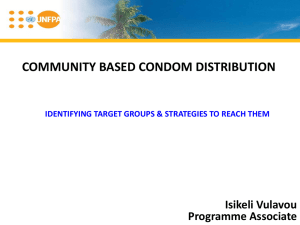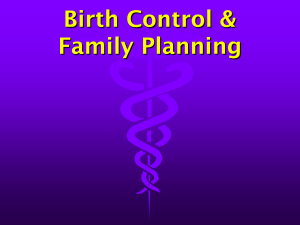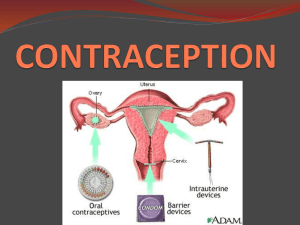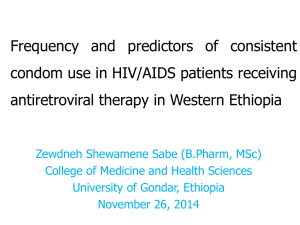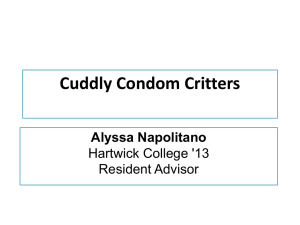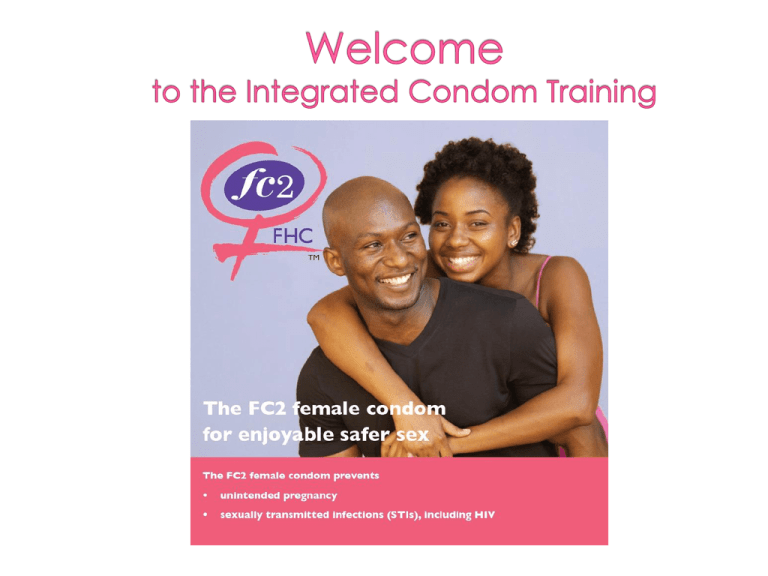
Learning objectives.
By the end of this module participants should be able to:
Explain the terms Dual Protection and Barrier Methods
in simple language.
Understand and explain the various strategies against
unintended pregnancy and STIs/HIV.
Resource 3.1- Dual Protection
Definition: A contraception method that can be used
to prevent both pregnancy and STI/HIV infections
Examples:
Male condoms
Female condoms
Resource 3.1- Dual Protection
A condom creates a physical barrier that prevents
semen or vaginal fluids and micro-organisms (e.g.
those causing gonorrhea, herpes or HIV) from
passing from one partner to the other during sex.
The condom also prevents contact with any
genital sores on the penis or vagina.
Resource 3.1 - Dual Protection
Various strategies:
Male or female condom use
Using two methods (e.g. condom + any other
contraceptive method)
Avoiding all forms of penetrative sexual relationships
Being faithful and using a contraceptive method to
prevent pregnancy
Do it yourself (self-stimulation)
Abstinence
Dual Protection messages may differ in different situations.
Resource 3.1 - Dual Protection
Learning objectives.
By the end of this module participants should be able to:
Explain what is meant by SRH rights.
State basic sexual and reproductive health rights.
Identify when rights are violated.
Argue the case for a woman’s right to practice dual
protection, and refute arguments against this right.
Resource 4.1- Sexual and Reproductive Health and Rights
Learning objectives.
By the end of this module participants should be able to:
Explain the terms Dual Protection and Barrier Methods
in simple language.
Understand and explain the various strategies against
unintended pregnancy and STIs/HIV.
Resource 5.2- Values Clarification
Learning objectives:
To allow participants to reflect on their values,
beliefs and attitudes.
To reflect on personal values and recognize how
they impact on interaction with clients.
To separate personal values from professional
values when interacting with clients.
Resource 5.2 – Values Clarification
A process of exploring our values, behaviours,
prejudices, attitudes and beliefs when dealing with
clients on a daily basis.
Resource 5.2 – Values Clarification
To explore our own personal and professional values.
To explore how values impact on quality of services.
To identify factors that may cause barriers to effective
provision of comprehensive RH Services.
To reinforce the importance of distinguishing between
personal and professional views in health care service
provision.
To increase confidence to talk about sex and sexuality.
Resource 5.2 – Values Clarification
Moral principle / one’s accepted standard.
What a person thinks is important.
That which directs our lives and gives meaning to
one’s life.
Something of worth, that is held dear by a person.
They form a basis for behaviour.
Resource 5.2 – Values Clarification
Opinion/religious faith.
Influenced by culture.
A principle accepted as true, not necessarily with
proof.
Different information/experience may change
beliefs.
Resource 5.2 – Values Clarification
Personally held feelings towards someone /
something.
Shaped by values or beliefs.
Influence behaviour.
Influence reaction to client presenting with SRH
issue because there is a conflict with the service
providers own value system.
Resource 5.2 – Values Clarification
Respect the values of others.
Don’t impose our values on others.
Accept that people are free to change and
update their values.
Assist clients to recognize values, beliefs and
attitudes that are placing them at risk of being
infected with HIV/STIs.
Be able to convince clients that risky behaviours
can be changed however difficult.
Resource 5.2 – Values Clarification
Do not get angry or frustrated with clients who
refuse to change risky behaviours.
Accept that some clients will take longer then
others to change behaviour.
Accept that only when an individual has
consciously accepted the risk and has made the
decision to change, he or she may change.
Clients need continuous counseling and support
without judgment.
Resource 5.2 – Values Clarification
How do your beliefs, values and attitudes affect
your communication with clients, colleagues and
others?
How far do your beliefs/values create barriers
between clients and effective service or quality of
care?
Resource 5.2 – Values Clarification
Health and other service providers need to revisit
own value systems to be able to serve clients with
objectivity without imposing own values.
Service providers who are self-aware are better
able to maintain a clear client-focus and respond
to their needs, feelings and concerns.
Resource 5.2 – Values Clarification
Learning objectives.
By the end of this module participants should be able to:
Explain the concept of gender.
Describe how gender affects vulnerability to STIs
including HIV.
Describe how gender issues can influence condom
promotion.
Resource 6.1- Gender & HIV/AIDS
Learning objectives.
By the end of this module participants should be able to:
Discuss the biological, social, cultural and economic
factors that contribute to the spread of STIs including
HIV/AIDS in men, women and children including
infants.
Discuss service-related reasons for failure to reduce
the spread of STIs.
Explain the importance of partner management and
how it can be achieved.
Resource 7.2 – Factors contributing to the spread of STIs/HIV
Resource 7.2 – Factors contributing to the spread of STIs/HIV
Learning objectives.
By the end of this module participants should be able to:
Define risky behavior.
Perform risk assessment with clients.
Train other health care providers to perform risk
assessment with clients.
Resource 8.1 – Risk Assessment
Learning objectives:
define risk assessment.
perform risk assessment with clients.
Resource 8.1 – Risk Assessment
- Unprotected Sexual Intercourse
- Behaviour:
Serial monogamy.
Sexual networking.
Casual sex.
Dry sex.
Number of partners.
Partners with multiple partners.
New partners.
Lack of condom use.
Incorrect or inconsistent condom use.
Low awareness of STI/HIV risks.
Inability to influence partner to use condoms.
Type of work.
Gender issues.
Resource 8.1 – Risk Assessment
- Clinical:
History of STIs.
Treatment of STIs.
Completion of treatment.
Treatment of partners.
Living with HIV.
Quality of the service provided.
Resource 8.1 – Risk Assessment
What is risky behaviour?
Any behaviour that predisposes clients to possible
STI/HIV infection or unintended pregnancies.
Resource 8.1 – Risk Assessment
Genetic make up.
Culture.
Religion.
Life style and work.
Personal factors.
Family and community.
Economics.
Physical environment.
Peers.
Media.
Resource 8.1 – Risk Assessment
A process.
Identification of risk factors.
Counseling.
Client identifies her/his problem.
Client makes own informed decision.
Resource 8.1 – Risk Assessment
Behaviour/s are difficult to change.
Behaviour change is a process.
Each client is unique.
Resource 8.1 – Risk Assessment
Lack of information.
Lack of understanding.
Lack of motivation.
Resistance to change.
Underestimating risks.
Personal circumstances.
Lack of support to sustain change.
Attitude of service providers.
Resource 8.1 – Risk Assessment
Assess client risk level.
Counsel and inform client of risk.
Identify barriers to change and discuss course of
action.
Give information on dual protection.
Discuss options for behaviour change.
Encourage Voluntary Counseling and Testing.
Resource 8.1 – Risk Assessment
Learning objectives.
By the end of this module participants should be able to:
Describe a range of different stages in the process of
behaviour change.
Demonstrate understanding of the process of
behaviour change.
Demonstrate how to help clients change their
behaviour.
Resource 9.1 – Stages of Behaviour Change
Resource 9.1 – Stages of Behaviour Change
Seek to establish where the client is.
Encourage movement from knowledge to
motivation.
Provide support for trying new behaviour.
Help evaluate the benefits of the new
behaviour.
Encourage sustained behaviour change
knowledge, attitude and skills.
Resource 9.1 – Stages of Behaviour Change
Adapt counseling to stage of each client
Resource 9.1 – Stages of Behaviour Change
Learning objectives.
By the end of this module participants should be able to:
Explain the importance of effective two-way communication in
service delivery.
Understand the difficulty many people experience in talking
about sex and sexuality.
Describe barriers to communication and factors that enhance
communication.
Engage more effectively in interpersonal communication.
Distinguish between passive, aggressive and assertive styles of
communication.
Monitor their own styles of communication and improve them.
Train, coach or mentor clients so as to help them communicate
more effectively.
Resource 10.1 – Communication Skills
Learning objectives:
To define communication.
To discuss the role of effective communication in
service delivery.
To discuss the different kinds of communication.
Resource 10.1 – Communication
One way.
Two way.
Verbal.
Non – Verbal.
Resource 10.1 – Communication
Motivational.
Promotional.
Information.
Counseling.
Resource 10.1 – Communication
Give full attention.
Be aware of body language.
Listen carefully.
Acknowledge client’s feelings and concerns.
Keep silent sometimes.
Paraphrase and clarify.
Be careful with the ‘why?’ word.
Reassure the client.
Resource 10.1 – Communication
Learning objectives.
By the end of this module participants should be able to:
Explain key principles of counseling.
State the rights of a client seeking FP/Dual Protection
services.
Demonstrate good counseling techniques.
Resource 11.1 – Counseling
Objectives:
Define counseling.
Demonstrate the principles and techniques of
counseling.
To assist providers to act as advocates for clients
by facilitating free informed choices.
Resource 11.1 – Counseling
Respectful.
Non-judgmental.
Genuine.
Warm.
Resource 11.1 – Counseling
Individualization.
Purposeful expression of feelings.
Controlled emotional environment.
Non-judgmental attitude.
Client self determination.
Acceptance.
Confidentially.
Counseling environment.
Dress code.
Resource 11.1 – Counseling
S
O
L
E
R
- Sit squarely facing client
- Open posture
- Lean forward
- Eye contact
- Relax
Resource 11.1 – Counseling
G
A
T
H
E
R
- Greet
- Ask / Assess
- Tell
- Help
- Explain
- Return visit
Resource 11.1 – Counseling
Give correct information.
Suggest options/choices.
Allow client to make an informed choice (client’s
rights).
Allow client to give an informed consent.
Resource 11.1 – Counseling
Learning objectives.
By the end of this module participants should be able to:
Locate and describe the main female reproductive
organs.
Have an understanding of FC2 Female Condom.
Describe the characteristics and advantages of FC2
and who can use it.
Resource 12.1 – Introduction to FC2 Female Condom
Mons pubis
Clitoris
Vaginal opening
Hymen
Urinary opening
Labia majora
Labia minora
Anus
Resource 12.1 – Introduction to FC2 Female Condom
Ovary
Fallopian tube
Cervical opening
Uterus
Bladder
Vagina
Resource 12.1 – Introduction to FC2 Female Condom
Resource 12.2 – Introduction to FC2 female condom
FC2 is inserted into the vagina before sex and holds the man’s
sperm after ejaculation.
FC2 is a strong, soft, nitrile sheath or pouch of 17 cm (6.5
inches- the same size as the male condom) in length.
Nitrile polymer forms an effective barrier against pregnancy
and sexually transmitted infections (STIs), including HIV.
Nitrile polymer (non-latex) is thin and strong and warms up to
body temperature.
Nitrile polymer is non-allergenic.
Each FC2 is tested electronically to assure its quality.
FC2 can be inserted prior to sex since it is worn by the woman
and the man doesn’t need to be erect.
FC2 cannot be used simultaneously with a male condom.
FC2 contains a silicone-based lubricant on the inside of the
condom, but additional lubrication can be used for extra
pleasure. FC2 does not contain spermicide.
Resource 12.2 – Introduction to FC2 female condom
FC2 has a flexible ring at the closed end
of the pouch with a slightly larger ring at
the open end.
At the closed end of the sheath, the
flexible ring is inserted into the vagina to
keep the female condom in place.
At the open end of the sheath, the ring
stays outside the vulva at the entrance of
the vagina.
Resource 12.2 – Introduction to FC2 female condom
The outer ring:
Acts as a guide during penis penetration.
Prevents the sheath from bunching up
inside the vagina.
Covers the genitalia and base of the
penis and adds extra protection against
transmission of STIs.
Resource 12.2 – Introduction to FC2 female condom
All women and men who want to prevent
unintended pregnancies and protect themselves
against STIs, including HIV.
Women/men who don’t want to use the male condom.
People who are allergic/sensitive to latex.
People who are HIV positive.
Women who are menstruating.
Women who have recently given birth.
Women who have a retroverted uterus.
Women who have had a hysterectomy.
Women who are (peri and post) menopausal.
Resource 12.2 – Introduction to FC2 female condom
Over 17 years of study have shown the female
condom is an effective barrier against many
common STIs, including HIV.
It is estimated that correct and consistent use of the
female condom for one year with an HIV+ partner
could reduce a woman’s risk of acquiring HIV by
90%.
Studies in the U.S. and internationally have found
that the prevalence of STIs decline and the rate of
protected sex acts increase when female condoms
are made available alongside the male condom.
Resource 12.2 – Introduction to FC2 female condom
In March 2009, FC2 was approved by the
United States Food and Drug Administration
(USFDA). FC2 is the only female condom that is
FDA approved.
In 2006, WHO judged FC2 to be acceptable
for purchase by UN agencies.
In 2005, FC2 received the CE mark in Europe.
Registration in approximately 120 countries.
Resource 12.2 – Introduction to FC2 female condom
Female condoms work to prevent pregnancy and
STIs, including HIV, by lining the inside of the vagina,
preventing skin touching skin.
They collect pre-cum and semen when a man
ejaculates, keeping sperm from entering the vagina
and thereby preventing pregnancy and reducing
the risk of STIs.
Women have options available to them to increase
protected sex acts and decrease the transmission of
STIs and unintended pregnancy. Providers play an
important role in presenting all the options of
protection to their clients.
Resource 12.2 – Introduction to FC2 female condom
Prevents pregnancy, STIs and HIV infection.
Provides pleasure for both men and women (double
pleasure rings).
It feels natural because it quickly warms up to body
temperature.
The female condom isn’t tight around the penis and
gives the man a natural sensation.
Female and male can initiate use.
Facilitates communication, instills confidence and
assertiveness in women.
Provides another option for women and men.
Lubrication makes sex more pleasurable for (peri and
post) menopausal women.
Resource 12.2 – Introduction to FC2 female condom
Can be inserted in advance and does not
require immediate removal after ejaculation.
Option for women and men who are allergic
to latex.
Can be used during menstruation.
Covers external genitalia partially in women,
giving a wider protection area.
A woman can urinate with the condom in the
vagina.
Resource 12.2 – Introduction to FC2 female condom
Insertion requires practice.
Inner ring may cause discomfort.
Penis may miss entry into sheath .
Awkward in some sexual positions.
Relatively expensive compared to male
condom.
Where to discard?
Perceived by some people as “unattractive”.
Resource 12.2 – Introduction to FC2 female condom
Issues related to insertion, noise and
discomfort can be solved by practice,
insertion some time before sexual intercourse
and additional lubrication.
Reluctance to try FC2 can be overcome by
shared experiences, practice and increased
awareness of the advantages of FC2.
Developing good communication and
negotiation skills can help increase use of
both male and female condoms.
Resource 12.2 – Introduction to FC2 female condom
Resource 12.2 – Introduction to FC2 female condom
Learning objectives.
By the end of this module participants should be able to:
Demonstrate correct use of the female condom.
Explain the use of the female condom to clients.
Be familiar with myths and fears regarding the female
condom.
Be able to address common questions, concerns and
provide solutions for successful FC2 use.
Resource 13.1 – Using and Promoting FC2 Female Condom
Resource 13.1 – Using and Promoting FC2 Female Condom
Resource 13.1 – Using and Promoting FC2 Female Condom
Resource 13.1 – Using and Promoting FC2 Female Condom
Resource 13.1 – Using and Promoting FC2 Female Condom
Resource 13.1 – Using and Promoting FC2 Female Condom
Resource 13.1 – Using and Promoting FC2 Female Condom
Resource 13.1 – Using and Promoting FC2 Female Condom
Resource 13.1 – Using and Promoting FC2 Female Condom
Resource 13.1 – Using and Promoting FC2 Female Condom
Resource 13.1 – Using and Promoting FC2 Female Condom
Resource 13.1 – Using and Promoting FC2 Female Condom
Resource 13.1 – Using and Promoting FC2 Female Condom
Discuss basic concepts
Use simple language
Maintain a non-judgmental attitude
Encourage interaction
Use humour, but carefully
Remember: the female condom is not replacing the
male condom.
Resource 13.2 – Using and Promoting FC2 Female Condom
Timing of insertion
Who inserts
Position for insertion
Sex positions
Removal
Disposal
Practice
Re-use? NO.
Use with male condom? NO.
Resource 13.2 – Using and Promoting FC2 Female Condom
Size
Rings
Appearance
Lubrication
Noise
Handling
Insertion
Resource 13.2 – Using and Promoting FC2 Female Condom
Positive attitude
Passionate about one’s health
Practice
Patience
Perseverance
Perfect User
Power
Protected
Pleasurable
Promote positively
Resource 13.2 – Using and Promoting FC2 Female Condom
Learning objectives.
By the end of this module participants should be able to:
Demonstrate correct use of the male condom.
Instruct others in correct use of the male condom;
Dispel myths and misconceptions about the male
condom.
Resource 14.1 – Male Condoms
Resource 14.1 – Male Condoms
Resource 14.2 – Male Condoms
The male condom is a sheath made of very thin
sensitive rubber latex.
It is designed to cover the erect penis and prevent
semen from entering the vagina.
The condom is often lubricated to minimize loss of
sensitivity during intercourse.
Resource 14.2 – Male Condoms
Male controlled barrier method.
Protects against pregnancy and against STIs,
including HIV.
-> When used correctly and consistently
Resource 14.2 – Male Condoms
Made in different sizes, colours, textures and thickness.
Fit tightly on the penis.
Have pores that are so small they do not allow even
the smallest viruses (like Hepatitis B, herpes simplex, or
the HIV virus) to pass through.
Some are lubricated with spermicide by the
manufacturer.
Can only be used with water-based lubrication.
The integrity of condoms can be undermined (i.e. they
can be damaged) by extremes of temperature.
Resource 14.2 – Male Condoms
The male condom is about 98% effective in
preventing pregnancy if used correctly and
consistently
Resource 14.2 – Male Condoms
People of all ages - except that:
A very small percentage of people cannot use the
latex condom because of sensitivity to latex (either
partner).
Some couples cannot use the male condom
because the male partner has difficulty
maintaining a complete erection.
Resource 14.2 – Male Condoms
Simple and easy to use with practice
Widely available and does not require any medical
prescription
Can be used either as a short term or long term method
Can be used to provide added protection (against STIs /
HIV) with other family planning methods – i.e. a dual method
Only used during the times you have sex
Promotes responsibility and accountability amongst users
Allows partners to share responsibility
No systemic side-effects
Can prolong sexual intercourse, particularly for men with
premature ejaculation
Resource 14.2 – Male Condoms
Can reduce male sensation.
Takes practice to use confidently and correctly.
Breakage or slippage may occur especially amongst
inexperienced or inconsistent users.
Interrupts sexual intercourse unless incorporated into
foreplay.
Sometimes perceived as promoting promiscuity.
If associated with STI/HIV prevention, may reduce the
ability of some individuals/couples to negotiate its use.
Some individuals may have occasional sensitivity to
latex.
General misperception of “very high failure rates”.
Requires a full erection for correct use.
Resource 14.2 – Male Condoms
Condoms often break during sex.
If the condom comes off or slips off it can travel
inside the woman’s body.
Use of condoms will weaken a man, causing
impotence.
If your partner suggests condom use, it is a sign of
unfaithfulness on their part.
Condoms are only used with women from areas
perceived as “cheap” and high risk.
Condoms are only for use with sex workers.
Resource 14.2 – Male Condoms
Resource 14.3 – Male Condoms
Learning objectives.
By the end of this module participants should be able to:
State country policy on emergency contraception.
Explain country guidelines on emergency
contraceptives;
Explain currently available emergency contraceptives
to potential clients;
Know what information to discuss with clients or users
in the case of unprotected sex, condom slipping or
breaking.
Resource 15.2 – Emergency Contraception
Learning objectives.
By the end of this module participants should be able to:
Conduct productive negotiations for safe sex, and
help others develop skills for doing so.
Discuss ways in which condoms (male and female)
can affect sexual pleasure, both positively and
adversely.
Use effective negotiation strategies in trying to deal
with aggression or violent behaviour in a sexual
partner, and help others develop skills for doing so.
Resource 16.1 – Negotiating Safer Sex
The process of negotiation involves at least two
people with two different views on an issue, in this
case, sexual behaviour.
Each person tries to persuade the other party to
support his/her view, a ‘win’ situation, or at least to
agree on a compromise or middle position, a ‘win,
win’ situation.
The goal that each woman and man must have is
to practice safer sex.
Resource 16.1 – Negotiating for safer sex
Safer sex depends on the ability to convince
partners that it is in their mutual best interests to
use a condom.
However, negotiations for safer sex are not always
easy.
Because it may be difficult to discuss the subject,
practicing safer sex may be very limited or just not
done
Resource 16.1 – Negotiating for safer sex
Persuasion.
Ability to assess the situation.
Good listening skills.
Knowledge to express ones self.
Appropriate timing.
Observation of non verbal skills.
Resource 16.1 – Negotiating for safer sex
Choose a relaxing environment in a neutral
location, preferably outside the bedroom, where
neither of you feel pressured.
Do not wait until you or your partner are sexually
aroused to discuss safer sex. In the heat of the
moment, you and your partner may be unable to
talk effectively.
Use “I” statements when talking. For example, “I
would feel more comfortable if we used a
condom”
Resource 16.1 – Negotiating for safer sex
Be a good listener. Let your partner know that you
hear, understand, and care about what she/he is
saying and feeling.
Be “ask-able” – let your partner know that you are
open to questions and that you won’t jump on
him/her or be offended by questions.
Be patient and remain firm in your decision that
talking is important.
Resource 16.1 – Negotiating for safer sex
Recognize your limits. You don’t have to know all
the answers.
Avoid making assumptions.
Ask open-ended questions to discuss
expectations, past and present sexual
relationships, contraceptive use, HIV testing, etc.
For example, “What do you think about us both
going for an HIV test?”
Resource 16.1 – Negotiating for safer sex
Ask questions to clarify what you believe you
heard. For example, “I think you said you want us
to use condoms. Is that right?”
Avoid judging, labelling, blaming, threatening or
bribing your partner. Don’t let your partner judge,
label, threaten, or bribe you
Resource 16.1 – Negotiating for safer sex
Learning objectives.
By the end of this module participants should be able to:
Identify the likely learning needs of people to whom they
will pass on condom training in the future (outreach
workers, community based organizations, colleagues within
their own organizations or partner organizations…and so
on).
Identify the topics they will need to cover in their own future
trainings.
Select the most appropriate topics, activities and materials
from this manual.
Design appropriate condom training workshops to meet
the needs of people with whom they will work in the future.
Resource 17.1 – Planning Future Condom Training
Learning objectives.
By the end of this module we will have:
Obtained participants’ feedback on the training and shared
ideas for improving future trainings.
Completed the post-course questionnaire and compared results
with the pre-course questionnaire.
Administered and collected the participants’ workshop
evaluation forms.
Exchanged contact information.
Presented certificates.
Thanked everyone involved in the training.
Closed the workshop in a positive way/finished on a high note.
Resource 18.1 – Evaluation & Closing


